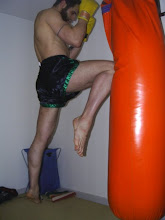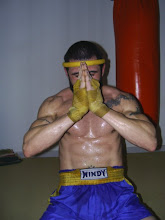 Equipment:
Equipment:-Bogu: Protective armor used in kendo
-Bokken / Bokuto: A wooden sword used in martial art and kendo training also known as a bokuto
-Dou: Chest protector in kendo. Also refers to the target area covered by the chest protector
-Gi: A training uniform, Upper part of the uniform, Short for keiko gi
-Hakama: A training uniform, Lower part of the uniform, Traditional pleated divided pants
-Katana: A Japanese long curved sword
-Men: Head or Head/face protector which is part of kendo protective armor
-Men Buton: The wing-like sides of the men
-Shinai: A kendo practice sword made of bamboo strips
-Himo: Strings, as on practice uniforms, protective equipment or armor
-Kote: Protective mitts that protect the hands and wrists that are a target
-Sakigawa: The leather tip of a shinai
-Tare: A kendo hip protector.
-Tenegui: A small cotton towel with a wide variety of uses, including to cover the -kendoka's head under the men
-Tsuba: A hand guard on a shinai, boken or sword.
Training Instructions:
-Ashibaki: Footwork
-Ayumiashi: A normal stride or walk
-Hajime: Begin
-Hidari: Left
-Hidari-Do: The left of the torso protector, a target in kendo-Hidari-Men: Left side of the head, a target in kendo
-Hikiwake: A draw (no winner) in a kendo match
-Haya suburi: Striking practice where sword strikes are done quickly while moving towards and then away from the target
-Ippon: One point
-Issoku-Itto No Ma: The basic combatant distance in kendo where one step forward will bring the two participants into striking range
-Kendoka: A kendo student or practitioner
-Kirikaeshi: The repetition of strokes of the shinai, often done as an opening exercise
-Mokuso: Command to close the eyes and begin meditation
-Mate: Wait, pause, stop
-Ma-Ai: Combative engagement distance
-Men Tori: A command to remove the men, or face/head protector used at part of kendo armor
-Migi: Right
-Migi-Do: The right side of the torso protector, a target in kendo
-Migi-Men: Right hand side of the head, a target in kendo
-Mushin: An empty and clear mind: a mind not fixed or occupied by thought or emotion and thus open to everything
-Okuriashi: A sliding step commonly used in kendo
-Rei: Bow
-Sage to: Carrying sword posture, the position used to carry a sword into the practice or performance area
-Seiza: Formal sitting
-Sempai: Seniors
-Sensei: Honorific expression used by students in addressing their teacher or instructor
-Shidachi: The defender in a kendo kata
-Shomen Uchi: A strike to the head
-Sonkyo: A crouching position used at the opening of kendo bouts wherein partners show one another respect before starting
-Suburi: Repetitious practice of basic sword strokes as in kendo
-Tenouchi: Gripping the shinai
-To Ma: A distance of more than one step (in order to strike) from an opponent
-Tsuba Zerai: A kendo technique of closing with the opponent and immobilizing their shinai at the hand guard
-Tsuki: A thrust to the throat that is a target area
-Tsukuri: A pulling action used to off balance an opponent in kendo
-Uchi Dachi: The aggressor in kendo kata
-Uchikomi: Attack practice done repeatedly
-Yame: Command to stop or finish
-Zarei: A bow from a kneeling position
Stance-Chudan No Kamae: A stance in kendo in which the opponent is faced directly and the shinai is held at the center of the body
-Gedan No Kamae: Stance in which one faces the opponent directly, but the shinai is held with the tip pointing towards the opponent's knees
-Hanmi: Triangular stance, where one foot is in front of the other and where the hips are at a 45 degree angle to the opponent
-Harai Waza: Warding off techniques
-Jodan No Kamae: A sword stance where the sword is held with both hands high above the head, elbows spread wide to maximize vision, one of the basic combative engagement postures in swordsmanship and kendo
-Hasso No Kamae: A stance where the sword or shinai is held at the right side of the head, one of the basic stances (kamae) in the sword arts
-Kaeshi Waza: Deflecting a shinai by using the power of the opponent's strike
-Kamae: Combative engagement postures
-Kansetsu Waza: Joint techniques or attacks
-Kata: A prearranged sequence of movements
-Katsu: Resuscitation techniques
-Nidan Waza: Two step techniques
-Nuki Waza: Techniques that utilize dodge tactics
-Oji Waza: The practice of feints, deflections or parrying followed up with an immediate counter of a technique
-Sandan Waza: Three step techniques
-Sayu Men: Strikes to alternate sides of the men
-Shikake Waza: Catching an opponent off guard and attacking
-Shinzentai: A natural stance
-Suriage Waza: A method of sliding up a shinai (practice sword) to ward off an shinai attack so as to be able to counter attack
-Uchi Otoshi Waza: Practice of striking a shinai (practice sword) down and immediately attacking
-Zanshin: Passive, non-threatening stances and kneeling in such a way as to be always ready to draw a sword indicate the fact that
Other:-Chikaku: A position of advantage outside of an opponents front foot.
Chu: Middle, or center
-Dan: A category used to describe the rank (black belt or dan level) of an advance practitioner of a martial art
-Dojo: A martial arts training hall
-Hanshi: An honorary certificate signifying a master, usually issued to those who have achieved a ninth or tenth dan
-Hantei: A judgment or decision as in a tournament
-Jin: Tendons or muscles
-Kamiza: A place of honor or deity seat often the front wall of a dojo were there may be a Shinto altar, scroll or picture of a teacher or founder
-Kiai: A shout which can have an incredible emotional impact. To hear the kiai in a kendo training hall is to experience kiai as the unity of body and spirit
-Kissaki: The point of a shinai or tip of a sword
-Kodachi: A Japanese short sword
-Onegaishimasu: A formal way of asking for a favor which in kendo and other martial arts has come to mean, "please practice with me," the wording used (often with a seated bow) to start practice
-Renshi: An honorary certificate signifying a trainer, usually issued to those who have achieved a fourth through sixth dan
-Saika tanden: A point on the lower abdomen, also called the center, considered to be the body's center of gravity and locus of energy
-Shiai: Contest
-Shiaijo: Contest area
-Shimpam: A referee
-Shoshinha: A beginner in kendo
-Tachi: A Japanese long sword
-Taikai: Tournament
-Taiko: A large drum used for signaling in many traditional dojos, such as to call class to order
-Uke: Partner, the person being thrown
-Waza: Technique
-Zen Nippon Kendo Remei: All Japan Kendo Federation
Image Taken from: martialartsfashion.com
 Krabi Krabong is a weapon-based martial art from Thailand, not much know about this art but this martial art is indeed an affective one. Just like other martial arts, Krabi Krabong was featured in movies as well, in James Bond “The Man with the Golden Gun” Krabi Krabong uses up to 20 weapons for combat training, which below are only a few examples:
Krabi Krabong is a weapon-based martial art from Thailand, not much know about this art but this martial art is indeed an affective one. Just like other martial arts, Krabi Krabong was featured in movies as well, in James Bond “The Man with the Golden Gun” Krabi Krabong uses up to 20 weapons for combat training, which below are only a few examples:














